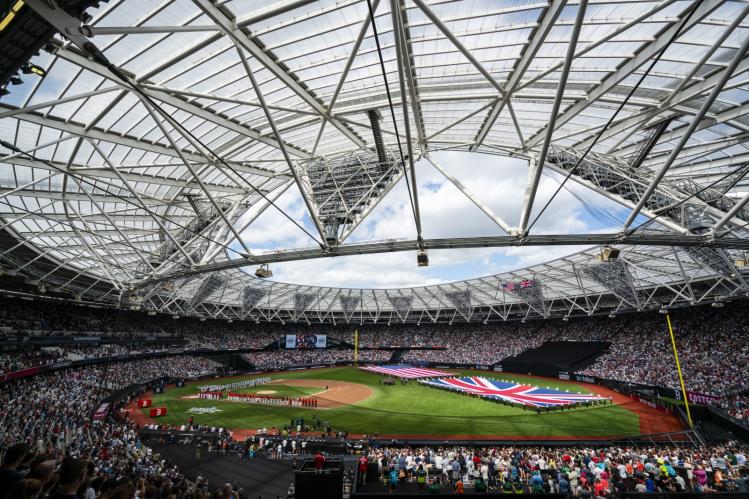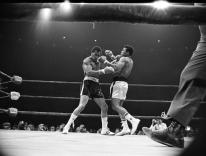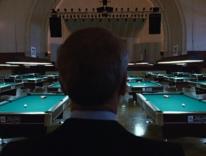
Even by the standards of the ever-expanding business of professional sports, baseball in London didn’t immediately strike me as a winner.
The National Football League has hosted regular-season games in the British capital since 2007, and the National Basketball Association since 2011, but there’s a large and growing appetite for both sports in the United Kingdom. Baseball, on the other hand, remains far less known on this side of the Atlantic. While enormously popular in the Caribbean and in Japan, it’s never been of much interest to the English—who already have the closely-related game of cricket—or to Continental Europeans, who tend to follow some combination of tennis, cycling, rugby, and soccer during the summer months. Baseball isn’t the most accessible sport, either. Games are long, the rules are complicated, and a lot of time is spent waiting for things to happen. That’s a source of intrigue and beauty for the well-initiated, but it all can seem boring if you have no idea what’s going on.
None of that put a damper on my joy when Major League Baseball (MLB) announced a two-game series between the Boston Red Sox and New York Yankees at London’s ex-Olympic Stadium the last weekend in June. I admit that I was delighted just to have games closer to my time zone. Since I moved to Paris three years ago, my Red Sox fandom has suffered from the fact that most games are damn-near impossible to watch. There are the rare Sunday day games, which begin at a very reasonable 7:05 PM Central European Time, and sometimes I can catch late-afternoon weekend games (4:05 PM in New York, 10:05 PM in Paris). But most MLB games are played at night (7:05 PM in New York, 1:05 AM in Paris). I’ve had to drag myself out of bed at three or four in the morning to catch the last few innings of a Red Sox playoff game; when they won the World Series last year, I witnessed the end of the game during an early morning shift at my television-news job.
In other words, being a baseball fan in Europe has been a largely solitary experience, one of those things I’ve learned to keep to myself, like my obsession with country music and Ken Burns documentaries. But as I learned at the London series, there are actually plenty of others like me. Last weekend, 120,000 of them filled the sold-out seats at London Stadium for both games combined. About thirty percent of the tickets were sold in the United States, according to MLB, a figure that also includes season-ticket holders of the Red Sox and Yankees. But the other 70 percent were sold in the United Kingdom, that is, to actual baseball fans in Europe. Many were Americans, but not all of them.
That included people like Pepe Anderson, a 50-year-old from the Dominican Republic who’s lived in London for the last 15 years. “This is history,” he told me with a smile at a bar just outside the stadium on Sunday. He was sporting a Yankees cap and a jersey from the East London Latin Boys, the amateur baseball team, made up of mostly Dominicans, that he manages. Anderson told me he watches about three pre-recorded games a week.
Or Craig Tomkins, a native of the Boston suburb of Newton, Massachusetts in his early 60s, who was enjoying a beer outside a different bar before Sunday’s game. After overhearing that I was a reporter, he seemed to jump right into the role he wanted to play. “Let me tell ya something,” he said, “the Red Soahhhx are Goaahhd’s team. They’re Go-ahhd’s team.”
Then there was Teis Peterson, 33, and his friend Ulrick Pluggte, 34, both of whom flew in from Copenhagen for the weekend to catch the games. They said they started as Patriots fans, before getting into the Celtics and the Bruins—and then, finally, the Red Sox. “If you follow one team from Boston, you start following them all,” Peterson told me.
“Fair enough,” I replied, “but how did you become Boston fans then?”
“Nobody knows,” he said, shrugging his shoulders.
Perhaps my skepticism was overblown. If you build it, they will come, I guess.
While finding a stadium large enough to meet the outsized demand for tickets to the games is one thing, ensuring that stadium includes a quality playing field is another. In some ways, this should be easier for baseball—unlike in the NFL, NBA, or NHL, the sport has no standard field size. The dimensions of professional soccer pitches also vary slightly, but not nearly to the same extent as in baseball. This is one of baseball’s enduring, endearing particularities and one that gives real meaning to the idea of home-field advantage.
Even so, London Stadium was especially atypical. The fence in straight-away center field stood a mere 385 feet away from home plate, making it practically the shortest such distance in Major League Baseball this year. A section of the center field fence at Boston’s Fenway Park comes within 380 feet away from the batter, but it’s also complemented by a seventeen-foot-high wall and it extends rightward on a diagonal line to 420 feet. Center field at Yankee Stadium, meanwhile, is at 408 feet.
London’s ballpark also featured massive foul ground on both sides of the diamond. At a total of 44,500 square feet, the stadium measures 3,000 square feet larger than its closest competitor, the famously spacious Oakland Coliseum, also meant to be shared with the NFL. This changes the game quite a bit: For one, it means balls that are in-play have more space to bounce around in foul territory, potentially allowing baserunners to advance. But more importantly, it gives the pitching team an opportunity to record outs on pop-ups that would reach the stands in most stadiums. Fielders who want to take advantage of this extra space have to hone in on the ball as soon as it leaves the bat, then maniacally sprint at it. All their usual instincts about foul balls have to be recalibrated.
“The biggest thing I noticed was the foul territory,” Michael Chavis, the 23-year-old rookie first-baseman for the Red Sox, told me on the field after hitting batting practice on Sunday. “When a fly ball goes up in the infield, you can’t really take your eye off it.”
There were also no difference in texture between the turf on the field (imported from France) and what’s known as the warning track, the brown-colored surface that extends around the grass of the field and signals to fielders when they’re about to hit the wall—it usually is made of the same dirt as the infield. “Obviously there’s a color difference, but the warning track’s the field,” Chavis said. “You don’t know when you’re hitting the warning track, so you got a combination of trying to find the ball and find[ing] out where you’re at.”
After seeing Chavis make a spectacular diving catch in foul ground and then, on a separate occasion, awkwardly slam into the wall chasing a pop-up, I understood exactly what he’d been talking about.
There was much speculation the field was affecting play after Saturday’s game, which the Yankees won by a very un-baseball-like score of 17-13. Not just its dimensions or its fast-moving artificial turf, but somehow, in some mysterious way, the aerodynamics of the stadium. This can sound ridiculous to non-baseball fans. But small things can make a difference in a sport in which a hitter who finishes his career making outs 70 percent of the time is considered far superior to someone who fails 75 percent of the time. Denver’s Coors’ Field is regarded as the league’s greatest hitters’ park simply because of its high altitude.
Tony La Russa, the World Series-winning former manager of the St. Louis Cardinals who now works as an advisor in the Red Sox front office, seemed sympathetic to the aerodynamic theory behind the high scoring on Saturday. “Pitchers appeared to have trouble locating and getting their normal movement, whether it was fastballs or breaking balls,” La Russa told me during batting practice before the game on Sunday. “Maybe it’s just a matter of adjustment, or maybe there are other factors. You need more than one game to see.”
A few hours later, the Yankees put on yet another offensive display, clobbering the Red Sox 12-8. The fact is, though, La Russa is right: we probably need more than two games to see what’s going on. Are the Yankees simply a great offensive team? Was the Red Sox pitching just lackluster? Is the particular angle of the awning around London Stadium creating a high-pressure funnel aimed at the pitcher’s mound that’s undetectable to anyone other than the world’s leading physicists?
In baseball, answers to big questions like these tend only to be unlocked after extended periods of time. The regular season is 162 games long, double the number of NBA and NHL games and more than nine times the amount of those played in a regular NFL season. Distinctions in baseball are subtle and take a long time to be sorted out. If you put the best American football team on a field against the worst one, the outcome is near-certain. Not so in baseball. The best teams are those who survive a six month grind, and if they can manage to win six games out of every ten, they’re seen as excellent.
Apparently, Major League Baseball high-brass was satisfied with the London experiment. There are already two games scheduled here next June between the St. Louis Cardinals and the Chicago Cubs, and Commissioner Rob Manfred said over the weekend that he wants “sustained play” in Europe going forward. Other European cities reportedly have already reached out to MLB about hosting such games.
It seems like an idea worth pursuing. Baseball is suffering from a well-documented decline in popularity in the United States, and if there are fans abroad who are passionate about the game, then why not bring it to them? It should just follow some key conditions: Players need to be adequately compensated for the grueling journey across time zones. Games in Europe also shouldn’t come at the expense of other more well-established baseball hotbeds outside the continental United States and Canada: places like Puerto Rico, Japan, the Dominican Republic, or Cuba (assuming the White House has a new occupant come 2021). Finally, the games should be affordable for fans, though this may be wishful thinking for a league whose average ticket prices hover over $30. The cheapest seats in London were $38. It is hard to separate the league’s choice of venue from its intentions to keep prices above a certain level.
Still, one of the great sights at London Stadium was the number of flags from around the world. Like at an international soccer match, some fans draped themselves in their country’s colors or hung them from walls inside the ballpark—from Venezuela, the Dominican Republic, the Netherlands, Curaçao, and Cuba. It was a reminder that baseball is an international game, after all.
Hopefully, fans will get to see just a little less scoring next year.
“The defensive game, when the pitching’s really effective, that’s also a beautiful part of it,” La Russa told me. “You need to see both to really understand how great the game can be.”
Please email comments to [email protected] and join the conversation on our Facebook page.
Share
Previous Story
‘That All May Be One’
Next Story
Small Graces

